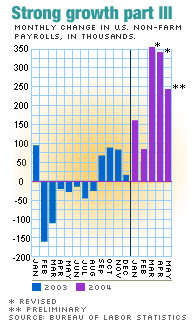NEW YORK (CNN/Money) - The jobless recovery is over, killed by several months of strong jobs growth. The question now for economists and job seekers is how much longer the current hiring boom can last.
A three-month stretch of strong jobs growth is expected to extend Friday when the June employment report comes out.
The consensus forecast of economists is for a gain of 250,000 new jobs, slightly above the 248,000 net job gain reported in May. The range of estimates goes from 185,000 from Wells Fargo Bank to a 310,000 job gain forecast by Thompson Financial. The unemployment rate is forecast to stay unchanged at 5.6 percent.
Some economists, including those at Wachovia Securities, believe the current run of quarter-million monthly jobs growth can basically continue unchecked all the way through the end of the decade.
"I don't see any storm clouds on the economic horizon," said Mark Vitner, senior economist with Wachovia Securities, who is forecasting 270,000 new jobs in the June report. "We don't see any potential land mines or problem areas. Even an attack on the scale of 9/11 would not cause the economy to go into recession in the next two years."
Vitner said that while hiring seemed to lag economic growth in the current recovery, it was low corporate revenue growth in the early quarters of the recovery that kept the cap on hiring.
"It wasn't until the fourth quarter of 2003 that corporate revenue was growing. Without that, hiring additional workers didn't pay for itself. Now, as you have revenue growth greater than the cost of compensation, it pays to hire more workers."

Vitner said he's not suggesting there won't be any months before 2010 with less than 250,000 jobs added; he just believes they will generally be isolated. He says when jobs growth numbers do dip that hiring will quickly rise above that higher threshold again.
A prolonged period of strong jobs growth would not be unprecedented. It's not even ancient history. From 1993 through April of 2000, a period of 88 months, saw better than 250,000 jobs added in 48 of them, and in 27 of those months job gains came in at 300,000 or better.
But some economists say the hiring patterns of the 1990s won't be revisited by businesses any time soon, even if the economy and corporate revenues continue to grow.
"We had a lot of companies in that period that were not making money, hiring a lot of people who were not doing anything for their pay," said Drew Matus, senior economist at Lehman Brothers.
"That kind of idea of job growth is something we might have to get over now that the bubble is over."
Matus' estimate for June's employment gain is a touch higher than Vitner's -- he sees 275,000 jobs being added. But he said the current expansion doesn't have the legs to make it all the way to 2006, let alone the end of the decade.
"Could it last six months? Yes. A year? Maybe. Two years? No way," he said.
Most other economists are like Matus, generally optimistic about job growth at least through the next quarter, probably through the rest of this year.
| Related stories
|

|
|
|
|
"For the moment the third quarter is probably going to be similar to what we saw the last three months -- probably between 250,000 to 300,000 new jobs every month," said Anthony Chan chief economist for Banc One Investment Advisors Corp.
But Chan and many other economists say the current jobs growth cycle is likely to start to lose steam by some point in 2005, although they're not forecasting the kind of job losses the economy saw from mid-2001 through mid-2003.
"Unfortunately I do see the economy slowing down a bit next year, but I think we can glide down to a path where employment gains are closer to 200,000 than 250,000," he said.
But some economists believe that the factors which led to the jobless recovery in 2002 and 2003 will keep hiring growth lower than past expansions, even if the economy continues to grow.
"Businesses are still awfully cautious about hiring," said Sung Won Sohn, chief economist at Wells Fargo who has the least optimistic 185,000 job-gain forecast for the June report. "They used to hire in anticipation of increase in demand. [Now] they try to wait till the last minute."
Sohn also sees signs in recent consumer spending and manufacturing reports that the strong growth seen in the first half of 2004 may be slowing.
"Nothing goes up in a straight line. We might see a slow down or pause in hiring," he said.
However Paul Reilly, CEO of Korn/Ferry International, the executive search firm, said that job search orders he's seeing from employers suggest there's no let-up in hiring in the near-term and that he fully expects the strong growth to continue into at least 2006.
Reilly said even if there is a slowing in the pace of growth in the total number of people employed, the number of people being hired could see strength due to the increasing number of retirements in the coming years as the post-World War II baby boom generation ages.
"Between 2000 and 2020, you'll see 50 million people retiring to be replaced by 30 million," he said. "The sign is that the market is robust and activity is strong and will continue to be strong."

|


